 |
and an introduction to the railway |
 |
and an introduction to the railway |
The South Tynedale Railway The South Tynedale Railway is a new narrow gauge railway, built to British two feet gauge or 610 mm metric equivalent, which runs from Alston in Cumbria, into Northumberland, in Northern England. It has been constructed by volunteers on the formation of a former standard gauge branch line from the historic Newcastle and Carlisle Railway.
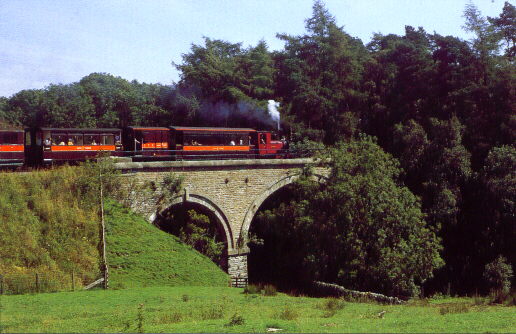
Photo: HELEN KATHRYN hauling a passenger train on Gilderdale Viaduct. It is one of five viaducts, which were constructed to the south of Lambley. This viaduct on the line forms the boundary between the counties of Cumbria and Northumberland. It is a historic monument, one of four historic viaducts along the line. Photograph by Tom Bell.
Two hundred years ago, Alston was the commercial centre of an important lead mining area, producing about 10,000 tonnes of lead per year. On 26th August 1846, the Newcastle and Carlisle Railway Company obtained an Act of Parliament, allowing it to build a branch line, 27 kilometres long, to the lead mines of the North Pennines at Nenthead.
On 13th July 1849, a second Act was obtained allowing the Company to abandon the very steep section of 6.4 kilometres from Alston to Nenthead, and to improve the alignment between Alston and the Newcastle and Carlisle main line at Haltwhistle. The construction then proceeded rapidly and the line was opened in sections, between March 1851 and 17th November 1852. The plans for the line showed three viaducts over the River South Tyne and seven embankments over its tributaries. In the north, the contractors followed the plans reasonably carefully, constructing one viaduct and two embankments, but to the south, different contractors replaced five embankments by five viaducts and altered the gradient of the line, so that a ninth viaduct was required. The branch line served the communities of the South Tyne Valley for 126 years, until it was closed completely on 1st May 1976.
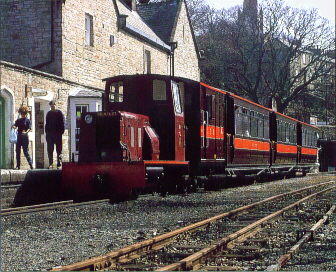
Photo: 0-4-0 diesel locomotive no. 9, built by Hunslet of Leeds in 1952, with a train of three carriages and guards van. The station at Alston was opened to goods traffic on 5th January 1852, but passenger trains did not commence until 21 May 1852. Passenger trains terminated at Lambley until the completion of the Lambley Viaduct. The viaduct was opened to rail traffic on 17th November 1852. Photograph by Tom Bell.
Following the announcement in 1973, that the Haltwhistle to Alston branch line was to close three years later, the South Tynedale Railway Preservation Society was formed. The original intention was to purchase the entire line, but this plan failed and the standard gauge track was rapidly lifted.
On 2nd July 1977, the members of the Society decided to build a narrow gauge line along part of the old formation and reached agreements with Northumberland and Cumbria County Councils who had purchased the trackbed. Passenger trains started running on 30th July 1983 to a temporary terminus, named Gilderdale Halt, about one mile north of Alston. The Society has permission to extend the line to Slaggyford village in Northumberland and has opened two extensions, on 12th December 1986 and 4th September 1999. Today the line is 2¼ miles or 3.6 kilometres long, with trains terminating in Northumberland at the new station of Kirkhaugh.
When work started on rebuilding the railway, the Society did not possess any workshops or buildings, in which to store the locomotives and carriages, but at the beginning of 1984, the volunteers started to construct a building to house the locomotives. Now, the Society owns three buildings in which the volunteers can undertake the complete rebuilding of all rolling stock and to store the majority of the vehicles.
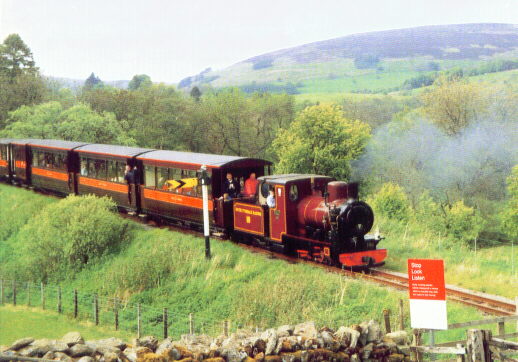
Photo: NAKLO, in rebuilt condition, approaches a level crossing, used by farm vehicles, near Kirkhaugh Station. Photograph by Tom Bell.
The Society has three steam locomotives, three diesel locomotives, one battery electric locomotive, six carriages, one brake van and thirty wagons. The volunteers have constructed the wooden bodies of the brake/buffet van and three carriages on the chassis of former military wagons. The steel bodies and chassis of the three other carriages were built for the Society and the members fitted out their interiors and undertook the paintwork.
The steam locomotives are:-
6 THOMAS EDMONDSON - 0-4-0 tank locomotive, built by Henschel & Sohn, of Germany in 1918. This locomotive was built for the Tigris Kreigsbahn in Turkey, but was never delivered and was purchased by the Spanish Military for use in Morocco. It was returned to Spain, where it worked for the Servico Militar de Ferrocarriles, Cuatro Vientos, in Madrid. In 1962 it was sold to the Minas y Ferrocarriles de Utrillas S.A., and in 1984 it was sold to the STRPS and delivered to Alston, where the volunteers returned it to service. In 2003, the Society received a grant of £35,000 from the Heritage Lottery Fund to return the locomotive to its original condition. In service from September 2006.
10 NAKLO - 0-6-0 locomotive built by Chrzanow, in Poland in 1957, rebuilt at Alston in 2001. In service.
14 HELEN KATHRYN - 0-4-0 tank locomotive built by Henschel & Sohn, of Germany, in 1948. In service.
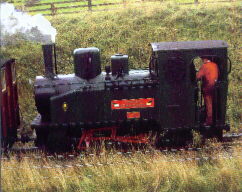
Photo: THOMAS EDMONDSON soon after making its debut in service on the South Tynedale Railway in 1987. Photograph by Tom Bell. 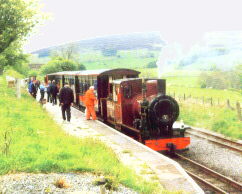
Photo: NAKLO, photographed after its rebuild before leaving the station at Kirkhaugh, the northern terminus of the line. Photograph by Tom Bell. The passenger service commences on Good Friday and trains run every weekend, bank and most school holidays until the end of October. Steam locomotives are used on trains on most Sundays in June and July and daily from the last week in July to the end of August. Special events for families and children, with steam locomotives in service, are run in May, June and October. Special steam trains with gifts for children and seasonal refreshments for adults are run in December, before Christmas.
For further information, including how to get to Alston by car or by bus, see the additional information page.
For more information about the South Tynedale Railway,
please contact:-THE SOUTH TYNEDALE RAILWAY PRESERVATION SOCIETY,
Registered Office Address:-
The Railway Station, Alston, Cumbria, CA9 3JB.
Telephone 01434 381696.
Talking timetable - Telephone 01434 382828.
Registered Charity No. 514939.
Limited by Guarantee: Company Registration No. 1850832 (England).E-mail enquiries - please click on links below:
South Tynedale Railway information - Send e-mail to South Tynedale Railway
STRPS membership information only - Send e-mail to Kathy Aveyard
Tynedalesman information only - Send e-mail to Tynedalesman compilersThis page was last updated on 1st December 2006.
© South Tynedale Railway Preservation Society 2007.